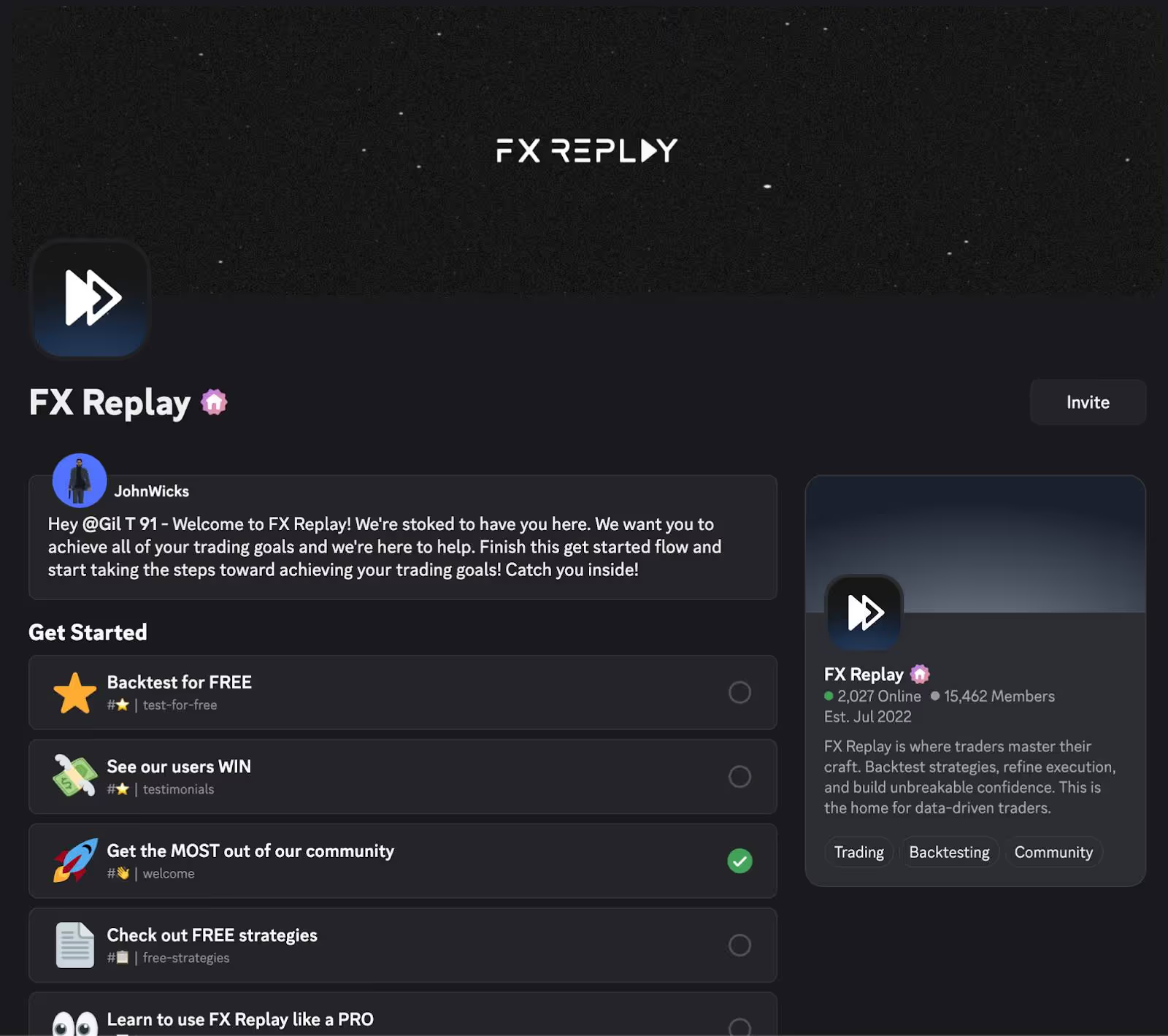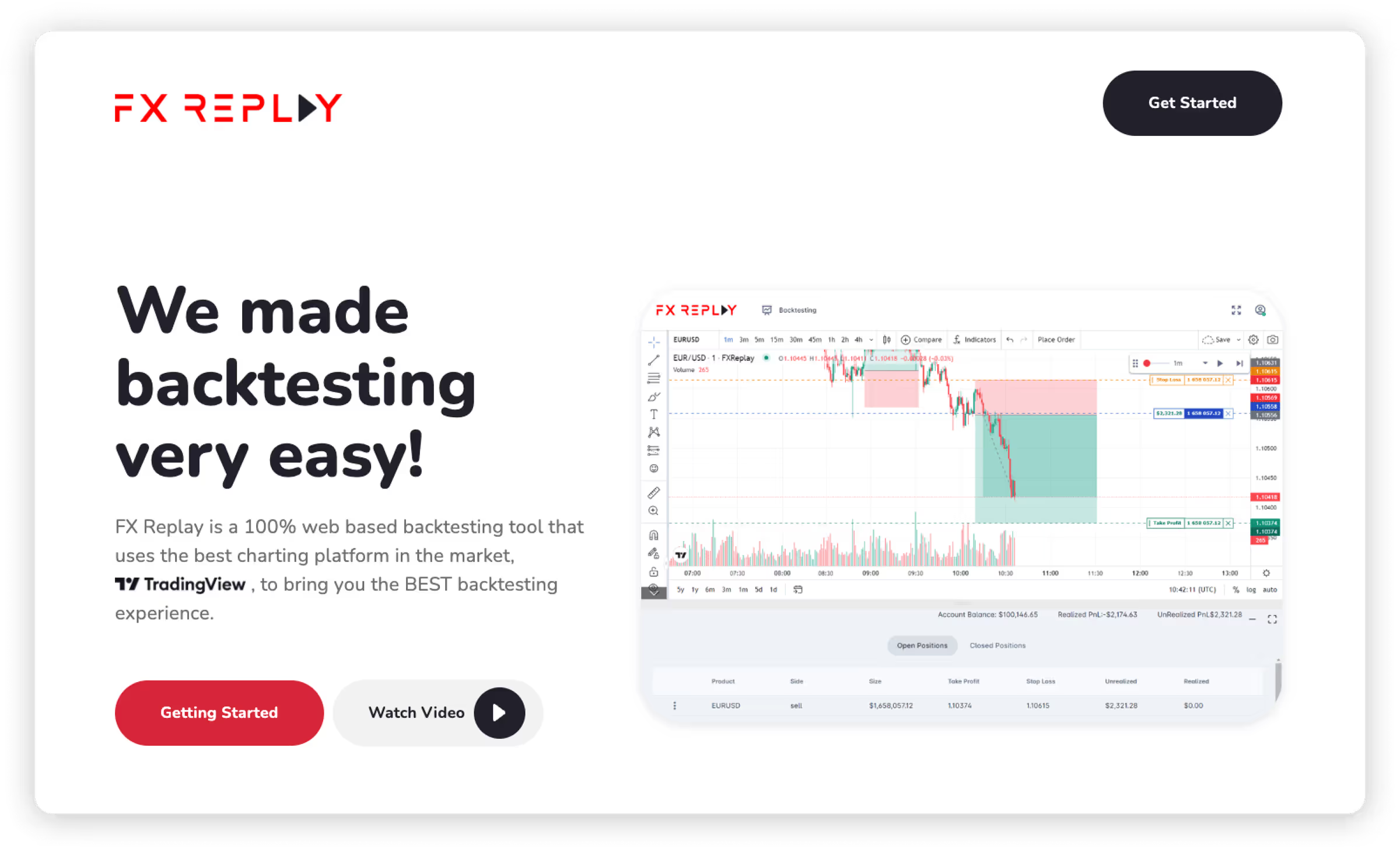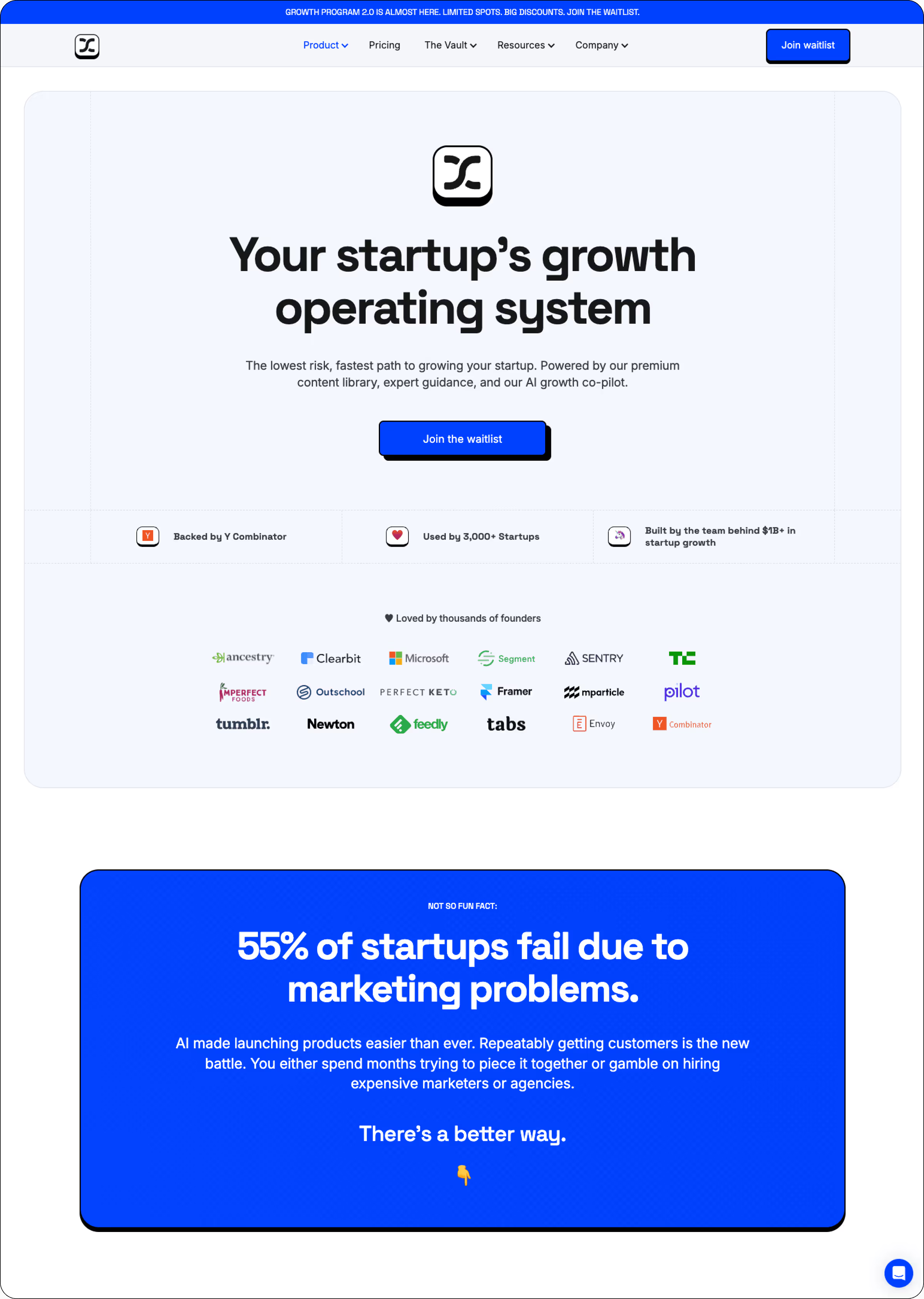Growth Newsletter #272
Last month, I interviewed Rodrigo Collao (known as "RC") and Matt Concordia from FX Replay. Two Growth Program alumni who built a stock trading simulation platform that grew to 100,000+ users across 160 countries in just over two years
They never raised venture capital. They didn’t run ads until recently. And neither of them had marketing experience when they started.
So what did they have working for them? They cracked a community-led growth strategy that not only propelled them to 100K+ users, but also acted as their crowdsourced product team.
What follows is the story of two traders who turned community feedback into a systematic growth engine, with practical lessons for founders and growth teams.
— Kevin
This week's tactics
From Discord Discourse to Dominance
Insight from Kevin DePopas, Demand Curve Chief Growth Officer + Gil Templeton, Staff Writer

RC and Matt were traders (and strangers) obsessed with the same thing, finding an automatable trading strategy that would make them millions.
The key to cracking this code hinged on “backtesting” which is basically a way to take a trading strategy like "buy when the price drops 10%" and testing it against years of historical market data to see if it would have made money. No real cash at risk, just practice runs on old data.
The problem was the existing backtesting software was complete garbage. And because of this, traders were either stuck using clunky programs, working in Excel spreadsheets, or gambling with real money to test their strategies.
Matt’s trading-themed YouTube videos caught the attention of RC, a software engineer and part-time trader. RC loved the videos, so he reached out through Discord, and the kindred spirits hit it off.
One night in their Discord chat, RC sent a message saying, "I think I know how I can build a backtesting platform."
Three months later, without warning, RC sent Matt a screen recording of him clicking through candlestick charts, demonstrating successful backtesting on a web interface.
"I was like, what the hell? How'd you do this?" Matt recalled.
RC had been building proof of concept while working full-time, but that was just the start of the slog.
The Year of No Weekends
Building the actual product was brutal.
For a year, RC would work his demanding full-time job, then come home to work on FX Replay until 2 AM, not to mention the marathon weekends. He was also on a work visa in the US that could be revoked at any moment, adding to the stress and uncertainty.
As RC built, Matt gathered feedback. In the spirit of co-creation, they created a Discord server where traders could test early versions and give feedback.

After over a year of iterating, it was time to make it real.
"It's now or never," RC told Matt two weeks before their launch in October 2022. "It's been going on for too long. We need to know if this is going to work or not."
RC pushed himself to his limits during those last two weeks. Even though the platform was missing dozens of features users desperately wanted, they shipped anyway.
Finally, RC sent Matt a message telling him to record the launch announcement. Right before collapsing into bed for two days, he checked Stripe.
"I saw somebody had already bought the trial and put their credit card down. That moment made everything seem worth it. I literally went to bed crying.”

The Growth Engine Nobody Teaches
By the end of month one: 100 paying users
Ten weeks in: 1,000 users
After eight months: 5,000 users
This was all without paid ads or a growth team. But how?
A key piece of their initial traction was Matt's existing audience. At the time, Matt had personally built a modest yet engaged following on Telegram, YouTube, and Instagram.
When most teams might see early community traction and conclude they need to double down on growing their own community organically, Matt decided to try replicating their community success with other existing trading communities.
Matt's strategy was deceptively simple: Turn community outreach into a systematic growth channel.
He went to other community leaders with this pitch:
"We'll give you a free account and a discount for your community. Just try it out, and share with them if you think they’d find it useful."
Even though there was no affiliate program at the time, many community leaders shared FX Replay with their audience freely and didn’t ask for a cut, because it was so valuable to their followers.
Matt was essentially running an outbound sales motion, but for community partnerships instead of customers. He emailed hundreds of trading influencers with personal, thoughtful messages after actually watching their content.
"I would always watch some of their stuff, so I could actually tailor a message to them," Matt explained. "If it's like, 'Hey, I watched this video and I really got a lot of value out of it. And I think your following can actually get value out of what we're making here too,' it hits a little harder."
While RC built features based on Discord feedback, Matt built relationships with community leaders. Because one community with 10,000 engaged traders beats cold-emailing 10,000 individuals.

Now is where most startup stories end with "and then we scaled." But not this one.
Leveling Up the Growth Engine
As they scaled past 5,000 users, Matt knew he needed to level up. They had traction, but he wanted more structure to test new channels and optimize conversion.
"I had little to no experience on the marketing side of things. I was trying to look and see, 'how can I be better at my job?'" Matt admitted.
He had a natural knack for growth but didn’t have the structure to scale systematically. That's when he found our Growth Program.
"It's different when there's a structured sequence showing you every step, from step one to step ten," Matt explained.

The program didn't transform them overnight, but it gave them a framework to understand and optimize what they were already doing right, and a method of testing new channels to see if they could unlock more growth.
"It helped assess our product, market, customers, and channels," Matt explained. "We were in a fortunate position with a lot of users and data, and we needed to do something with that to understand what they want, what they need."
Most importantly, it gave them the discipline to test methodically while staying grounded in what was working.

They launched a podcast, ran bi-weekly webinars, experimented with influencer partnerships, tried Snapchat ads (which flopped), and most recently began testing paid media. But here's the key, the program taught them to treat each channel as a hypothesis to test, rather than a shiny object to chase.
"It helped me focus on one channel and dial that in... because you spread yourself so thin when you try to do so many different things at once,” said Matt.
The program helped Matt understand why their community strategy worked (high-intent audiences and strong product-market fit), when to expand beyond it (after exhausting the channel and reaching a plateau), and how to build repeatable processes around what felt like lucky breaks.
Through this experimentation, the data kept pointing back to the same thing, community and word of mouth are the core of FX Replay's growth engine. RC estimates 90% of their users still come from word-of-mouth and community channels.
The Playbook You Can Actually Use
After dissecting their journey, here are the lessons you can take from FX Replay’s growth:
1. Solve a Problem You Live
Both RC and Matt were traders first and founders second. They didn’t have to study traders’ frustrations, because they felt them every day.
"Because we knew the problem so intimately, we knew what we needed to do to create an actual solution,” said Matt.
Today, FX Replay takes this concept even further by encouraging all their employees (devs included) to trade. Because when your team feels the same pain as your users, everyone is on the same page.
2. Ship the Core (But Make It Sharp)
We all know about MVPs. Eric Ries wrote The Lean Startup over a decade ago. Silicon Valley has been preaching "ship fast" ever since.
But user expectations have changed significantly over the last ten years. We've been spoiled by beautiful, intuitive apps. This means your MVP still needs to feel modern, even if it's not fully fleshed-out with features.
FX Replay launched with only two key features: Backtesting trades and seeing analytics. But those features ran smoothly behind a clean interface and didn’t require a download.
"People couldn't go back if they skipped forward too fast, and they were complaining about that for a long time," RC admitted.
So while some users complained about missing features, they still paid to support the vision, because the core experience was so solid.
3. Leverage Other Communities While Building Your Own
When founders hear "community-led growth," they usually think it means building their own communities from scratch (which can be a daunting undertaking). But Matt proved community-led growth doesn’t have to start and end with a community you own.
Instead of choosing between building their own community or partnering with others, Matt did both. While FX Replay invested in their own channels (Discord, webinars, podcasts, YouTube) they simultaneously turned existing trading communities into a distribution engine.
Give community leaders free accounts and member discounts. Ask them to try the product and share if they found value.
These external communities drove new user acquisition while FX Replay's own channels kept users engaged (and feeding the product roadmap).
Matt essentially systematized word-of-mouth growth through strategic community outreach, and you can too.
4. Discord as Your Product Development Lab
A lot of companies use Discord for support, but FX Replay turned Discord into their product team.
They let users suggest features, vote on priorities, and watch updates happen. This created a tight feedback loop where users felt like their fingerprints were all over the experience.
On top of getting great feedback, this created emotional investment. When users saw suggestions turn into updates and features, they became loyal. Plenty of users paid for a work-in-progress product just to help support its development.
5. Focus Wins Out (Even When You Test Everything)
FX Replay has tested a lot of growth channels, but they never turned their backs on what worked best.
Community outreach and word-of-mouth drove an estimated 90% of their growth from day one. Nearly three years later, those same key channels still drive roughly 90% of new users.
This mirrors a theme we've written about before, the best companies don't necessarily do one thing forever, but they tend to master one thing completely before adding more to the mix.
Bottom Line: Fundamentals Always Win
The most interesting part about FX Replay's story was that after a couple years and 100,000+ users, they're largely doing the same things that got them their initial traction.
Community outreach. Discord engagement. Building alongside users. Creating valuable content that teaches instead of promotes.
"More than the quantity is the quality," RC emphasized about their community relationships.
They didn't pivot to paid ads when they hit 1,000 users. They didn't raise venture capital at 50,000. They kept executing the fundamentals with a little more sophistication.
Matt and RC transformed from accidental marketers to intentional growth leaders through systematic learning and discipline. The Growth Program gave them the structure to understand why their organic success worked, and how to magnify it without muddying it.
No matter what kind of business or industry you’re in, you should follow their lead. Choose systems over hunches, and depth over breadth.
Kevin DePopas
Demand Curve Chief Growth Officer
Gil Templeton
Demand Curve Staff Writer
P.S. Want to build your own systematic growth engine? The Growth Program 2.0 teaches the same frameworks that helped RC and Matt scale FX Replay.
Learn more →







.avif)













